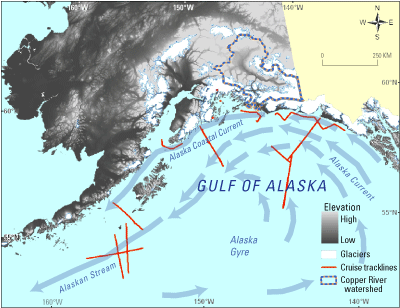Project: Influence of continental margin iron on phytoplankton species composition and production in the northern Gulf of Alaska
Description
Influence of continental margin iron on phytoplankton species composition and production in the northern Gulf of Alaska (part of Enhanced Phytoplankton Biomass-Northwest Gulf of Alaska)
The northern Gulf of Alaska (GOA) is among the ocean's most productive ecosystems and supports a rich coastal fisheries. Although strong cross-shelf gradients in phytoplankton (chlorophyll decreasing offshore) have been identified, yet the specific factors that regulate and control primary production have only been hypothesized. Cross-shelf patterns in primary production/species composition are consistent with a gradient of iron availability (Strom et al., in press), but this has yet to be rigorously tested. In collaboration with the NSF-funded project Mixing of iron-rich coastal waters with nutrient-rich HNLC waters leading to enhanced phytoplankton biomass: a focus on the northwest Gulf ofAlaska (K. Bruland), this project will examine the influence of cross-shelf exchange and physico-chemical gradients on phytoplankton distributions, physiology, and assemblage structure in the northern GOA, making use of complementary high-resolution iron data and building on the results from previous studies. The proposed work directly complements studies accomplished by the US GLOBEC Coastal Gulf of Alaska (CGOA) program, and is essential to link Bruland's study of trace metal dynamics and speciation to key biological processes. Bruland's project seeks to quantify the inputs of iron from the Copper River, AK, and to characterize and assess the interactions among river inputs and shelf/offshore systems. The quasi-synoptic sampling scheme enables characterization at the mesoscale, the dominant scale of variability in the region. The station grid allows quasi-synoptic sampling while remaining flexible to take advantage of interesting mesoscale features. Should a mesoscale eddy be present, the study will focus on the role that eddy circulation plays in facilitating the offshore transport (suggested by Stabeno et al., 2004) of bio-active trace metals.
This project aims to provide a detailed examination of the phytoplankton rates, assemblage structure, and response to cross-shelf transport/ mixing across gradients in iron and light to better parameterize satellite observations and future modeling efforts. Specific questions include: 1) Do cross-shelf gradients in iron correspond to patterns of carbon assimilation, nutrient uptake, new production, and species composition of phytoplankton in the northern GOA? 2) Do iron and light interact to structure species assemblages and patterns of carbon assimilation? 3) How do frontal regions influence phytoplankton distributions and physiology? 4) What bio-optical properties characterize the different water masses (inshore/offshore), and how well do satellite observations describe phytoplankton standing stocks and rates? 5) What chemical characteristics define the deep Fe-source identified by Lam et al. (2006), and what is the bioavailability of this material when mixed with near-surface waters? This study will provide the first concurrent measurements of iron concentration and phytoplankton physiological parameters in the waters of the northern GOA.
Broader Impacts. The proposed work will be extremely valuable in testing hypotheses arising from many years of effort by GLOBEC CGOA. Data from this study will further our understanding of ocean-climate interactions in an economically and ecologically important region. The results could have far-reaching implications for our basic understanding of coupled biogeochemical cycles in shelf ecosystems. This will have both direct and indirect impacts on our understanding of carbon cycling, as well as how other researchers parameterize regional and global biogeochemical models.
| Dataset | Latest Version Date | Current State |
|---|---|---|
| CTD profile data from R/V Thomas G. Thompson cruise TN210 in the Gulf of Alaska, North Pacific in 2007 (Northern Gulf of Alaska Phytoplankton project) | 2012-02-01 | Final no updates expected |
| Size-fractionated chlorophyll from R/V Thomas G. Thompson cruise TN210 in the Gulf of Alaska, North Pacific in 2007 (Northern Gulf of Alaska Phytoplankton project) | 2012-01-27 | Final no updates expected |
| Vertical profiles of primary productivity from R/V Thomas G. Thompson cruise TN210 in the Gulf of Alaska, North Pacific in 2007 (Northern Gulf of Alaska Phytoplankton project) | 2012-01-27 | Final no updates expected |
| Cruise track position data from R/V Thomas G. Thompson cruise TN210 in the Gulf of Alaska, North Pacific in 2007 (Northern Gulf of Alaska Phytoplankton project) | 2012-01-24 | Final no updates expected |

People
Principal Investigator: Raphael M. Kudela
University of California-Santa Cruz (UCSC)
Co-Principal Investigator: Christopher Edwards
University of California-Santa Cruz (UCSC)
